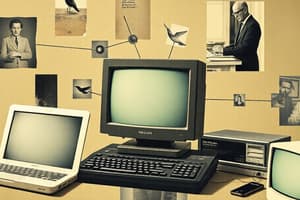Podcast
Questions and Answers
Which feature primarily affects the ability of a computer to perform multiple tasks simultaneously?
Which feature primarily affects the ability of a computer to perform multiple tasks simultaneously?
- Processor Architecture
- Storage Type
- Memory Capacity (correct)
- Operating System
What is the main function of input devices in a computer system?
What is the main function of input devices in a computer system?
- Manage hardware and software
- Display processed information
- Store permanent data
- Allow user interaction with data (correct)
How does storage type impact a computer's performance?
How does storage type impact a computer's performance?
- It affects data access times and storage costs (correct)
- It impacts the display type and size
- It enhances the security features of the system
- It determines the power requirements of the device
Which component is primarily responsible for managing computer hardware and software?
Which component is primarily responsible for managing computer hardware and software?
What aspect of networking affects a device's usability?
What aspect of networking affects a device's usability?
What is a distinguishing feature of laptops compared to personal computers?
What is a distinguishing feature of laptops compared to personal computers?
Which type of computing device is primarily focused on professional applications and demanding tasks?
Which type of computing device is primarily focused on professional applications and demanding tasks?
What is an essential feature of smartphones that distinguishes them from tablets?
What is an essential feature of smartphones that distinguishes them from tablets?
Which computing device is primarily used for handling high volumes of data and requests over a network?
Which computing device is primarily used for handling high volumes of data and requests over a network?
In which context would supercomputers typically be employed?
In which context would supercomputers typically be employed?
What characterizes embedded systems compared to general-purpose computers?
What characterizes embedded systems compared to general-purpose computers?
Which type of computing device lacks portability and is primarily used in large organizations?
Which type of computing device lacks portability and is primarily used in large organizations?
What is a primary use case for workstations compared to standard personal computers?
What is a primary use case for workstations compared to standard personal computers?
Flashcards
Personal Computers (PCs)
Personal Computers (PCs)
General-purpose computers designed for individual use, known for their versatility, modularity, and wide range of software.
Workstations
Workstations
High-performance computers with powerful processing capabilities and advanced graphics, often used for professional tasks.
Laptops/Notebooks
Laptops/Notebooks
Portable computers offering similar functionality to desktop PCs, known for their compact size and integrated components.
Tablets
Tablets
Signup and view all the flashcards
Smartphones
Smartphones
Signup and view all the flashcards
Servers
Servers
Signup and view all the flashcards
Mainframes
Mainframes
Signup and view all the flashcards
Supercomputers
Supercomputers
Signup and view all the flashcards
Processor (CPU)
Processor (CPU)
Signup and view all the flashcards
Memory (RAM)
Memory (RAM)
Signup and view all the flashcards
Storage (Hard Drive/SSD)
Storage (Hard Drive/SSD)
Signup and view all the flashcards
Input Devices
Input Devices
Signup and view all the flashcards
Output Devices
Output Devices
Signup and view all the flashcards
Study Notes
Types of Computing Devices
- Personal Computers (PCs): General-purpose computing devices, typically used by individuals. Versatile, modular, wide range of software options.
- Workstations: High-performance PCs for demanding tasks, often professional. More powerful processors, high-end graphics, substantial memory.
- Laptops/Notebooks: Portable PCs, similar functionality to desktops, portable form factor. Integrated components, lower power consumption, display, keyboard, battery, connectors.
- Tablets: Mobile devices with touchscreen interfaces, focusing on touch interaction. Smaller and thinner than laptops, information consumption, intuitive touchscreen applications.
- Smartphones: Mobile devices for communication and computation. Internet connectivity, apps, cameras, GPS, touchscreen interfaces. Prioritize portability, ease of use, communication.
- Servers: Powerful computers providing resources and services over a network. Designed for high volumes of data and requests. Extended hardware, power requirements for continuous operation.
- Mainframes: Large, high-performance computers for enterprise applications, massive data volume processing. Core of large corporations, used in industries like banking and finance.
- Supercomputers: Most powerful computers for complex scientific and engineering problems. Advanced parallel processing, enormous computational power. Used in weather forecasting, research, financial modeling.
- Embedded Systems: Specialized devices built into other devices, performing dedicated functions. Examples: watches, cars, appliances. Smaller, faster, more efficient than general-purpose systems.
Typical Features
- Processor (CPU): Processes instructions, performs calculations. Speed, number of cores, and architecture affect performance.
- Memory (RAM): Temporary storage for active data and instructions. Capacity impacts multitasking, application performance.
- Storage (Hard Drive/Solid State Drive): Permanent data storage. Capacity, speed, type affect data access times, storage costs.
- Input Devices: Allow data entry. Examples: keyboards, mice, touchscreens, microphones.
- Output Devices: Display/present processed information. Examples: screens, printers, speakers.
- Networking: Communication capabilities for connecting to devices/networks. Wired and wireless options.
- Operating System (OS): Software managing computer hardware and software. Different OSes support varied features, applications.
- Applications (Software): Programs performing specific tasks. Availability and versatility vary across devices.
- Power Requirements: Devices have different power needs, impacting portability, usability.
- Display Type and Size: Screen size, resolution, touch features, color range affect viewing, usability.
- Physical Form Factor: Devices in various forms (desktops, laptops, tablets, smartphones). Size and form impact portability, usability, and use cases.
- Security Features: Encryption, access controls, antivirus protect data, especially in networked systems.
Studying That Suits You
Use AI to generate personalized quizzes and flashcards to suit your learning preferences.




